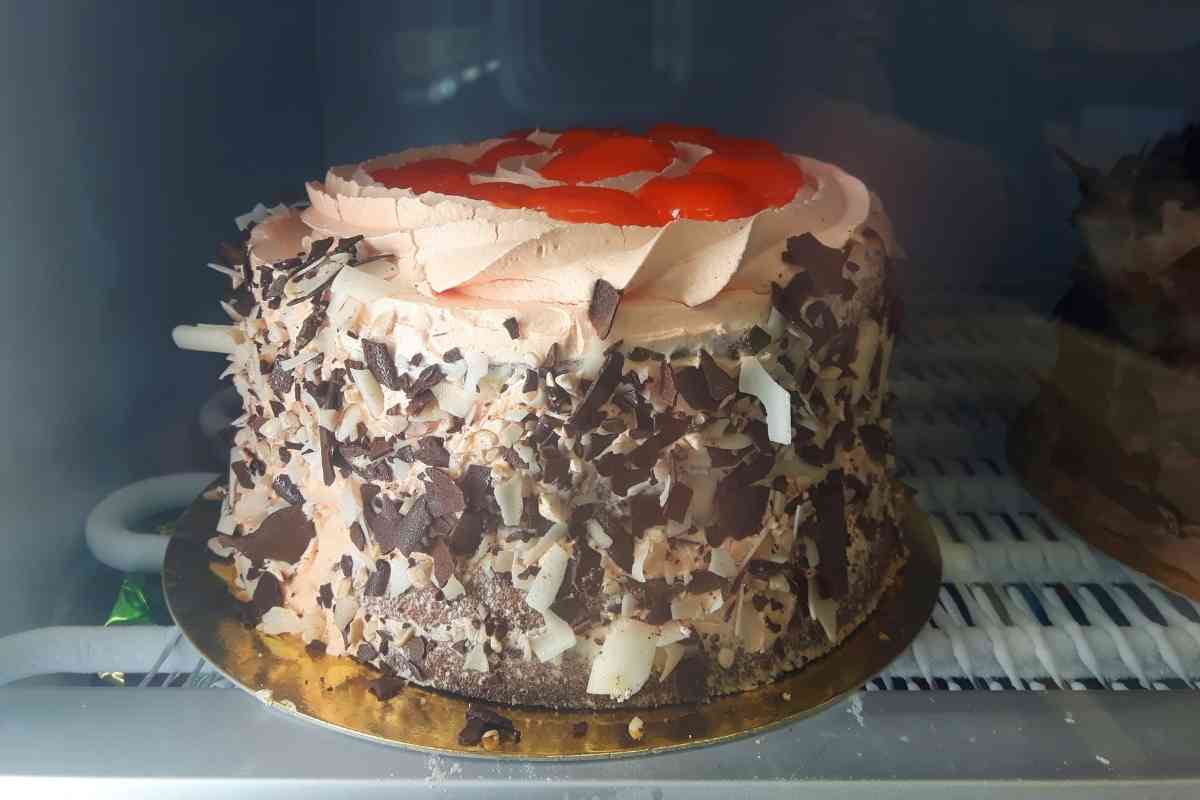Storing leftover cake properly ensures its delectable taste, soft texture, and frosting keeps for as long as possible. Most cakes can last for up to a week in the fridge and around three months in the freezer. The exact shelf life can vary depending on the ingredients, toppings, and storage method.
How Long Does Cake Last in the Fridge?
Store-bought cakes, which often have preservatives to extend shelf life, can usually last in the fridge for up to a week before they lose moisture and become dry. Homemade cakes typically last around three to five days. However, there are a lot of factors that can affect how long the cake lasts.
Frosting
Frosting can improve a cake’s shelf life, as the frosting seals moisture within the sponge and protects it from contaminants. When exposed to air, sponge quickly dries out and becomes stale.
Ingredients and Preparation
If the cake contains perishable ingredients like buttercream or cream cheese, it will only last for two to three days in the fridge. Fresh fruit cakes have an especially short shelf life, as fruit becomes brown, mushy, and sour quickly, even if stored at a cool temperature.
You can extend the life of a fresh fruit cake by glazing the fruit. The glaze stops the fruit from drying out and adds an attractive sheen.
Cakes with low moisture content, such as fruitcake, can last for several months in the fridge as long as they’re properly stored.
Storage
Keeping the cake in an airtight container — or covering it tightly in layers of plastic wrap — provides an additional barrier against air and helps the cake last for longer. It’ll also stop the cake from picking up other food odors from the fridge.
You should always let the cake cool to room temperature before storing it. This reduces the amount of moisture that accumulates and helps prevent the cake from becoming soggy.
How Long Does Cake Last in the Freezer?
Most cakes can be kept in the freezer for two to three months. You can keep cakes for longer than this, but they won’t taste as fresh and will likely experience changes in texture.
This is especially the case if the cake hasn’t been tightly wrapped before being put in the freezer. Exposure to the air speeds up the dehydration and oxidation process, causing the cake to lose moisture, develop ice crystals, and take on a discolored, shriveled appearance (a phenomenon more commonly known as freezer burn).
How to Store a Cake in the Freezer
Aside from tightly wrapping it, there are a few other ways you can make a cake last longer in the freezer:
- Keep the freezer at the right temperature. Ensure the freezer temperature is consistent and set at 0°F or lower. The lower the temperature is, the slower the loss of moisture.
- Keep the freezer door closed. Resist the temptation to open the door to check on the cake, as doing so will let warm air in and cause the temperature to fluctuate, potentially leading to more ice crystals.
- Wrap cake layers separately. If the cake has several layers, wrap each layer separately to stop them from sticking together during the thawing process.
- Chill the cake before freezing. Chill the cake in the fridge for a few hours before freezing.
- Don’t overcrowd the freezer. The freezer shouldn’t be more than three-quarters full. A jampacked freezer prevents the circulation of cool air and can lead to warm pockets that affect the overall temperature.
- Add a cup of water to the freezer. The water will evaporate and raise the freezer’s humidity, ultimately slowing down the dehydration process.
Can a Decorated Cake Be Kept in the Freezer?
A fully decorated cake can be kept in the freezer. However, it’s typically best to just freeze the sponge and apply the decorations when you want to serve it. The decorations, especially if they have a high-moisture content, will expand in the freezer and may lose their original shape and texture. Color dyes can also bleed and seep through the cake.
Even if the decorations do maintain their quality while frozen, the thawing process, which then causes the cake to expand, can still have an impact. The decorations can become damaged, smushed, or move out of place as they thaw.
How to Defrost a Cake
Defrosting cake is a relatively simple process. Transfer the cake to the refrigerator and let it thaw for at least eight hours, though ideally overnight. Individual cake slices thaw much quicker, typically within two to three hours.
Don’t remove any wrapping at this stage — it acts as a barrier against condensation and stops the cake from becoming soggy. The wrapping can also help the cake maintain its shape as it thaws.
Once fully thawed, carefully remove the wrapping and leave the cake on the counter until it’s ready to serve. Most cakes taste best at room temperature. If you need to add decorations, do so when the cake is slightly chilled, as it’ll be easier to work with.
Make sure not to defrost cake, especially whole cakes, at room temperature. If the cake warms up too fast, there’ll be too much moisture, and the sponge will become soggy and wet.
How to Store Different Types of Cake
Below, we’ve included some tips on how to store different kinds of cakes, including naked cakes, frosted cakes, and fruitcakes. When storing at room temperature, make sure to keep cakes away from direct sunlight.
- Naked cake: Cover in two layers of plastic wrap and keep in a secure container. It can last for two to three days at room temperature or up to five days in the fridge.
- Cake with non-dairy frosting or fillings: Can be kept in an airtight container at room temperature for up to five days or within the fridge for up to seven days. Keep in mind that some frostings won’t harden unless they’re chilled in the fridge.
- Cake with perishable frosting or fillings: Should be kept refrigerated and consumed within two to three days. Keep covered with plastic wrap, though let the frosting harden before covering the cake.
- Sliced cake: Sliced cake dries out more quickly than an entire cake as the sponge is fully exposed to the air. Make sure to cover with plastic wrap and keep it in an airtight container. Keep in the fridge for up to four days or up to two days if it contains perishable ingredients.
- Fruitcake: Most fruitcakes are low in moisture and contain plenty of preservatives. According to the U.S. Department of Agriculture, fruitcake can maintain its quality for up to three months in the refrigerator or up to a year in the freezer. You can also improve the shelf life of fruitcake by wrapping it in layers of alcohol-soaked cheesecloth.
How Long Before Cake Goes Bad?
Cake doesn’t spoil as easily as other foods. Most cakes keep their fresh taste and soft, moist texture if properly stored for three to five days. Even if a cake does become dry and stale, it can still be safe to eat it, as long as it doesn’t contain any fresh, perishable ingredients like fruit or whipped cream. You can even repurpose stale cake and use it to make new, delicious desserts.
With that said, you should always be wary of leftovers; some cakes can spoil far quicker than others. There are a few telltale signs a cake has gone bad and should be thrown away:
- Dry, crumbly texture
- Mold growth, whether on the cake’s exterior or in the filling
- Frosting is hard or discolored
- Slimy or soggy cake filling
- A sour taste
- Foul odor
Uses for Stale Cake
If the cake is still safe to consume, but has gone slightly stale, there are a few ways you can repurpose it to cut down on food waste.
You can use the cake to make a bread pudding, break it down and transform it into a crumble, or even mix it with cream cheese to create fun cake pops. You can also use it in desserts such as tiramisu or trifle — the cake layer will soak up the moisture and regain its soft texture.
Frequently Asked Questions
This can vary and depends on the type of cake and how it has been stored. Store-bought cakes without perishable ingredients, like fresh fruit or whipped cream, can likely still be safe to eat after six days.
However, cakes with perishable ingredients typically spoil within a few days. Most cakes turn stale after five days, even if properly stored.
You should always let the cake cool down before adding decorations. Otherwise, the warm temperature can cause the toppings to melt, move out of place, or not stick properly.
A cake that has gone stale will have a dry, crumbly texture. The frosting is also likely to be hard and flaky.
In most cases, you aren’t likely to get sick. Cake typically has a high sugar content and low moisture content, both qualities that make it resistant to mold and bacteria growth.
However, if the cake has fresh ingredients that have spoiled, it can potentially cause food poisoning and lead to symptoms such as stomach pain, nausea, and diarrhea.

